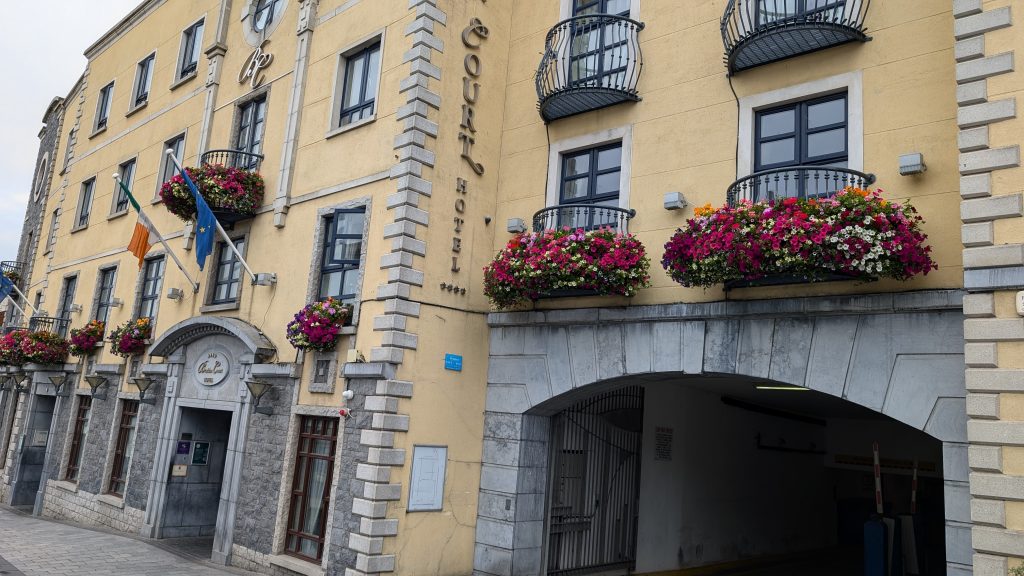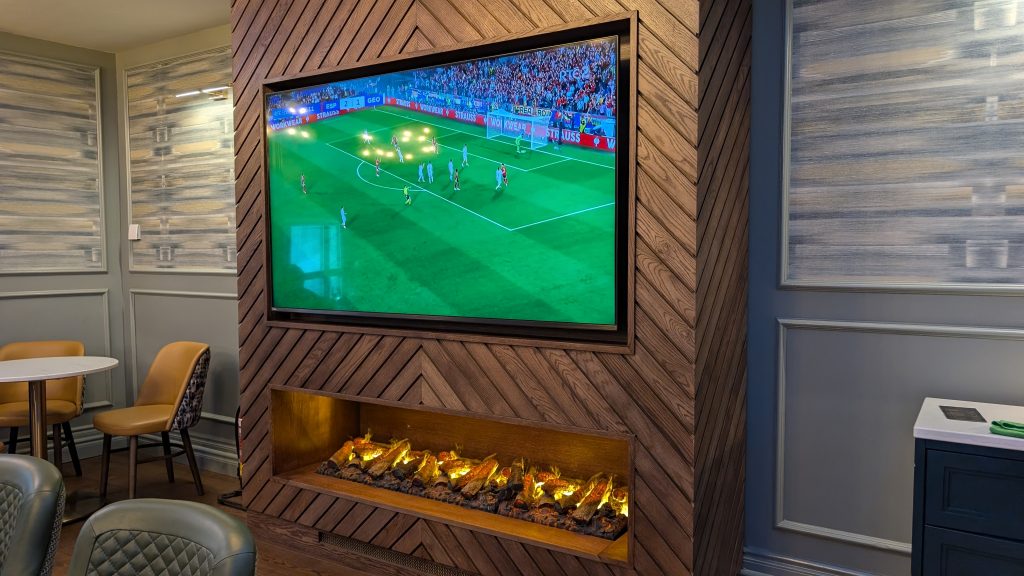Today we visited the castle before meeting up with a former colleague for a pint. I was excited to catch up with her, having just recently learned that she, her husband and two sons had moved from Minnesota USA to Dublin six months prior.
This is the town in which we stayed. It was about a 45 minute train ride to Dublin, then a 15-minute bus ride to the castle.
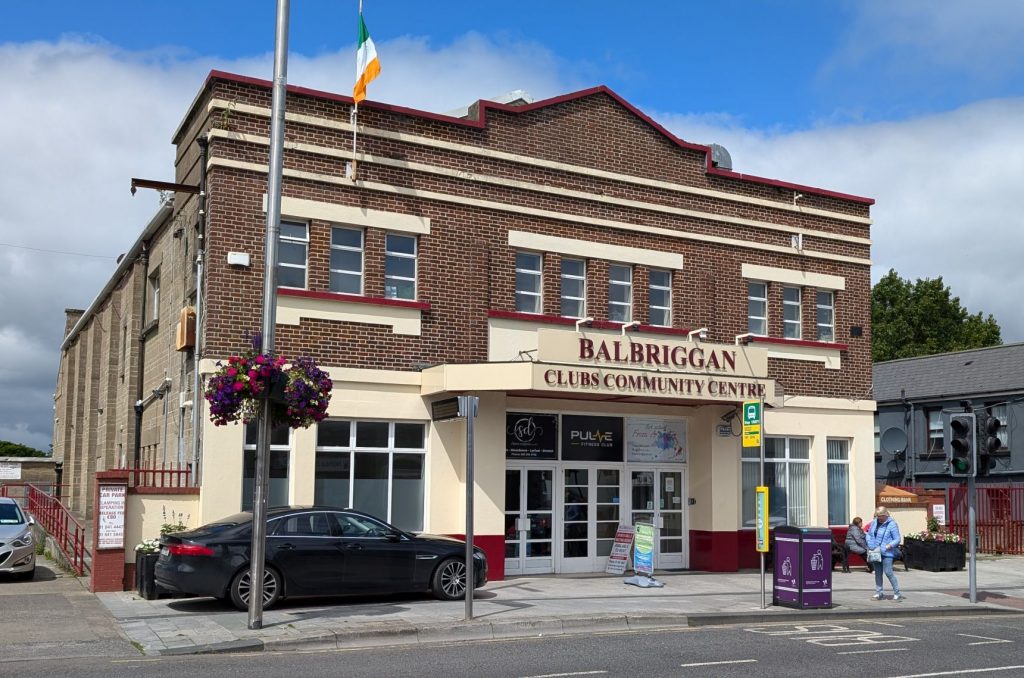
Dublin Castle
Dublin Castle is the heart of historic Dublin. It is one of the most important buildings in Irish history. The city gets its name from the Black Pool – ‘Dubh Linn’ – which was on the site of the present Castle garden where the River Liffey met the River Poddle. The original fortification may have been an early Gaelic Ring Fort. Later a Viking Fortress stood on this site. From 1204 until 1922 it was the seat of English, then British rule in Ireland. In 1922, following Ireland’s independence, Dublin Castle was handed over to the new Irish government. It is now a major government complex and a key tourist attraction.
After a fire in 1684 destroyed much of the Medieval Castle, the magnificent State Apartments were built as the residential quarters of the Viceregal court. They are now the venue for presidential inaugurations, official state visits, state functions, exhibitions and other events.
Paintings are a particular strength of the Dublin Castle collection, but it is also rich in sculpture, furniture, clocks, china, glassware, prints, tapestries, stained glass and textiles from the 17th century to the present day.
Battleaxe Staircase
The first thing you see when you enter the castle is the Battleaxe Staircase. This grand imperial staircase was the first of its type in Dublin. It dates from 1749. It takes its name from the Viceroy’s bodyguards, the Battleaxe Guards, who once stood guard at the top of it. In the dark days of January, candles were lit and red carpet was rolled out on this staircase, as the Viceroy prepared to host some of Ireland’s grandest banquets and balls during the annual social season.
At the top of the stairs above the double doors, visitors see the national emblem of Ireland, the harp. This emblem is unique, as Ireland is the only country in the world to have a musical instrument as its national symbol.
Today, the Battleaxe Staircase is the setting for the first formal photograph of each new President of Ireland.
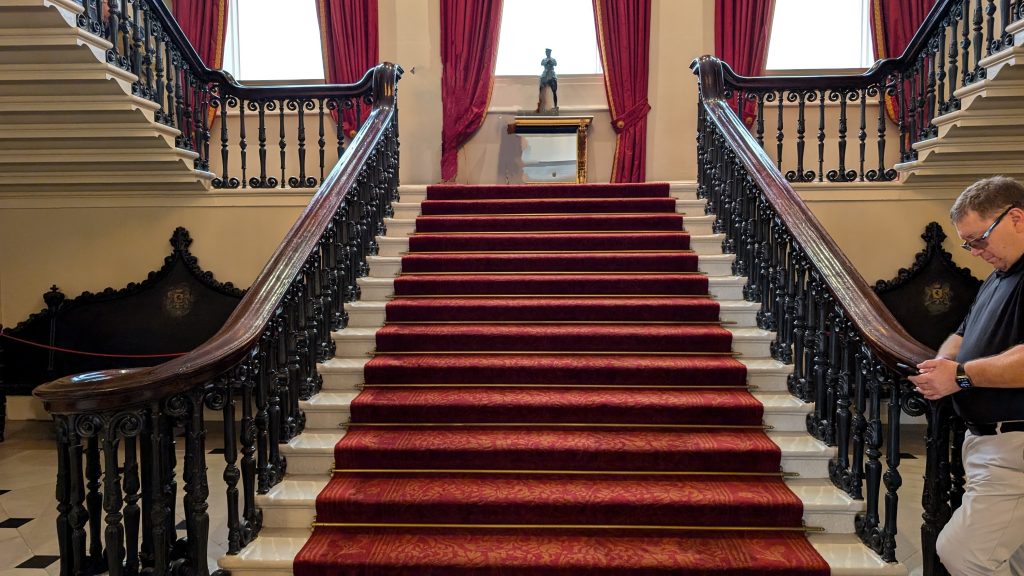
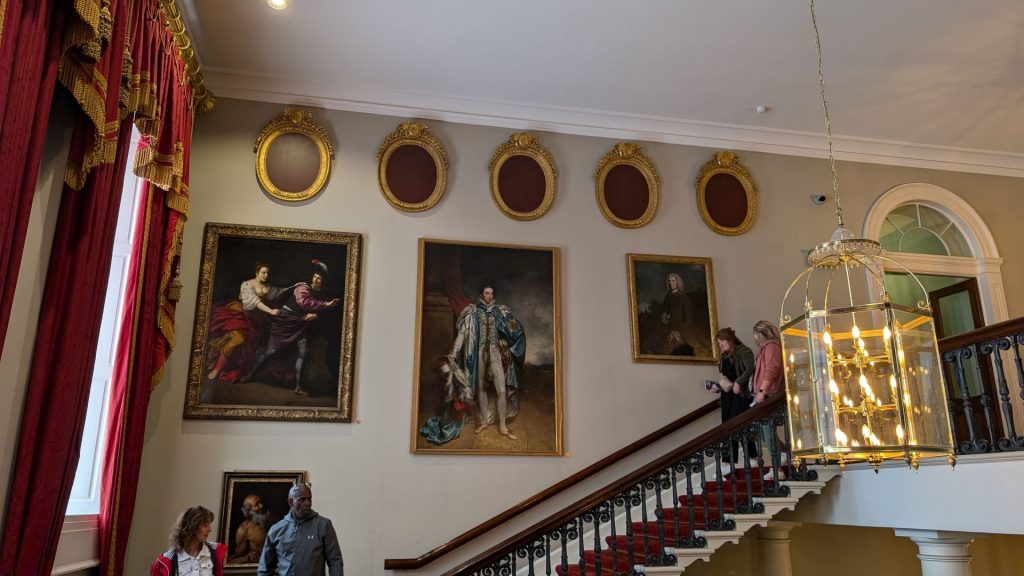
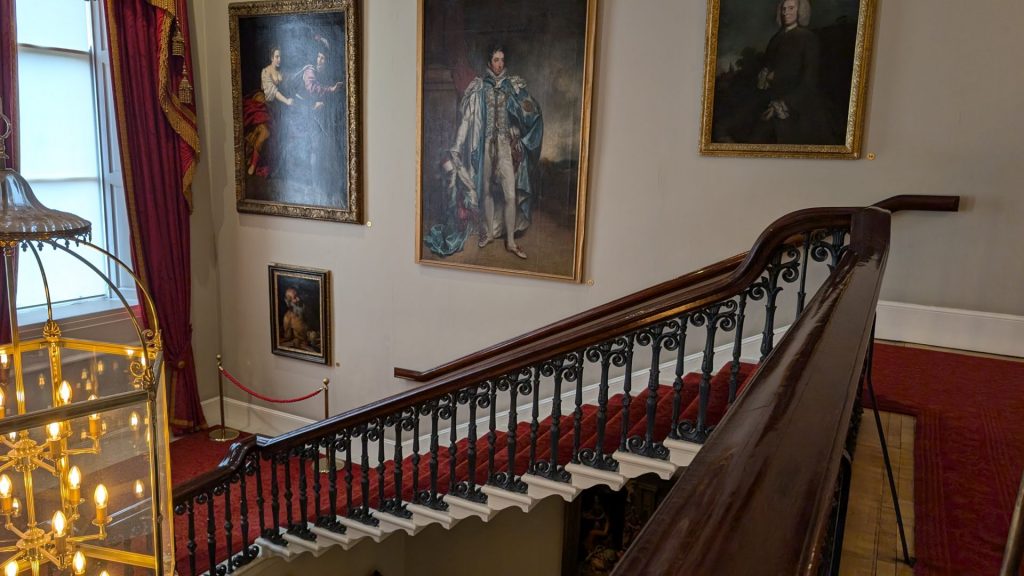
This showy portrait (below) on the wall of the Battleaxe Staircase provides a detailed record of the costume worn by Henry Boyle for his installation as a knight of St Patrick. The Order of St Patrick was a British order of chivalry associated with Ireland and was founded in 1783. Boyle’s installation ceremony took place on June 29, 1809. It was followed by a banquet in St Patrick’s Hall at Dublin Castle.
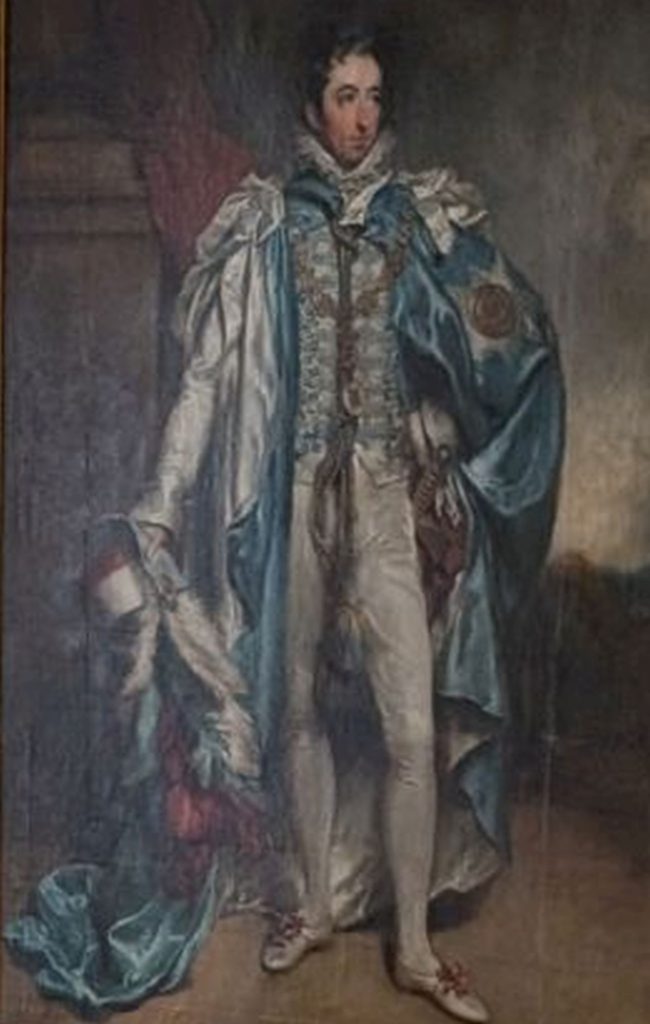
More artwork: Ezekiel and the Dry Bones. Artist: Crispiaen van den Broeck (1524-1589/91):
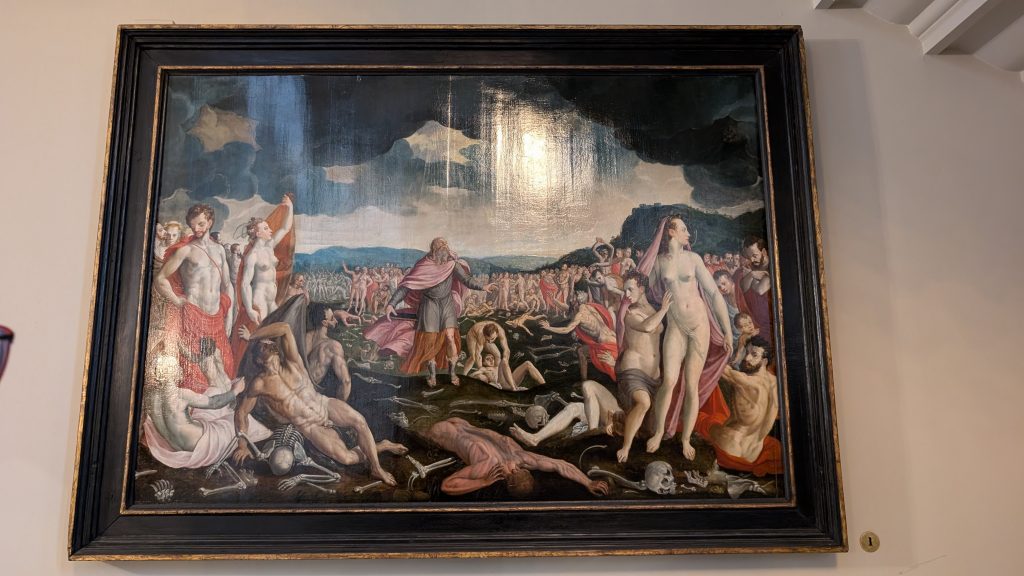
Also posted on the staircase wall: St Jerome Holding a Skull and a Book. (The title is quite literal!) Artist: Bernardo Strozzi, called “Il Cappuccino” (1581-1644).
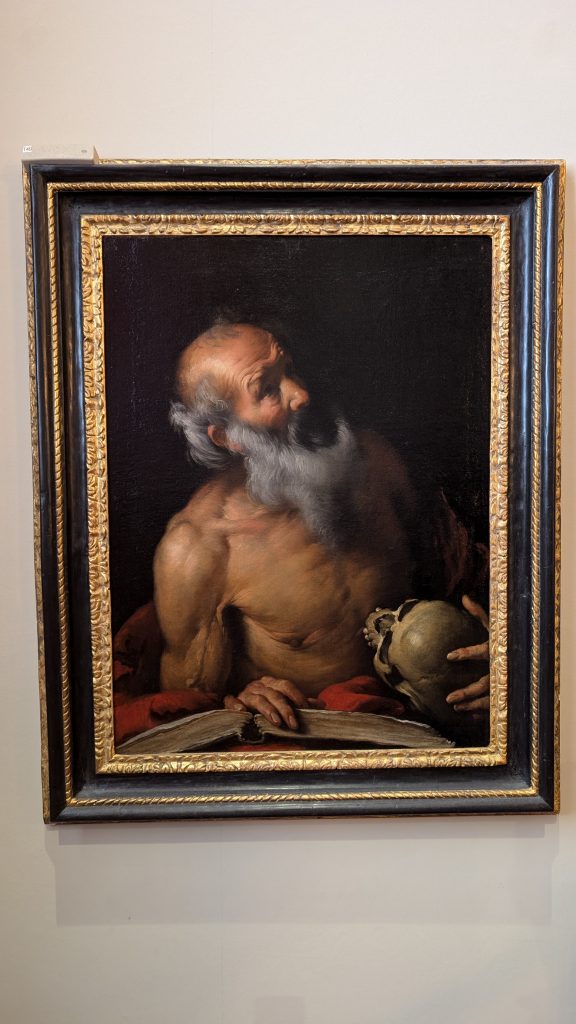
State Apartments
The State Apartments, located in the southern range of buildings of the Upper Yard, contain the rooms formerly used by the Lord Lieutenant for personal accommodation and public entertaining during the Castle Season. Today these richly decorated rooms are used by the Irish government for official engagements including policy launches, hosting of State Visit ceremonial, and the inauguration of the President every seven years. The apartments and their collections form an accredited museum.
The James Connolly Room
The room was once part of the Viceroy’s quarters. In 1915 this room, together with the rest of the State Apartments, became a Red Cross Hospital for soldiers wounded in World War I. This small room played a big part in the story of modern Ireland. It was here, in 1916, that James Connolly was treated for the injuries he had sustained in leading a rebellion against British rule in Ireland. Known as the Easter Rising, the rebellion resulted in the execution of the rebel leaders. On May 12, 1916, James Connolly was brought from here to be executed at Kilmainham Gaol.
The execution of Connolly and his fellow leaders provoked outrage in Ireland, turning the tide firmly in favor of independence from Britain. The Irish War of Independence followed.
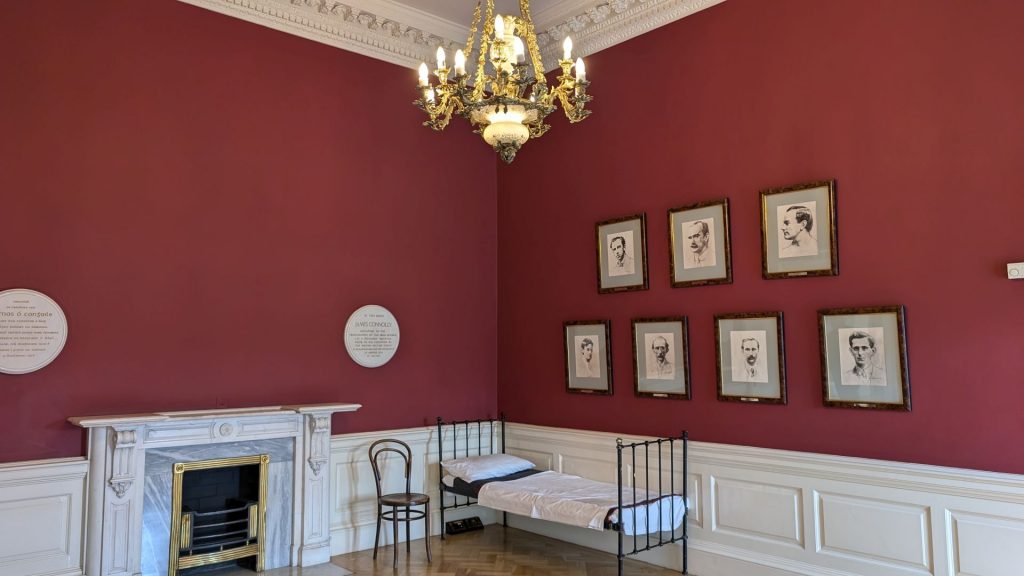
The State Corridor
This grand processional corridor was designed by the architect Thomas Eyre in 1758. It divided the public reception rooms of the State Apartments, to the left, from the semi-private quarters of the Viceroy and his wife, the Vicereine, to the right.
The State Corridor is one of the architectural highlights of Dublin Castle. The State Corridor as it exists today is hung with the portraits of every Irish President since independence and it is ornamented with a small collection of late 18th century Italian urns in the Neoclassical Style. These are the remnants of one of the most important collections of sculpture assembled in Ireland in the Late Georgian Period and were acquired in Rome by Valentine Lawless, 2nd Earl of Cloncurry, on his Grand Tour between 1803-1805. Of these, the most important is a pair of large Campana Urns executed in white Carrara marble, one depicting Apollo and the Muses and the other a Bacchanalian Dance.
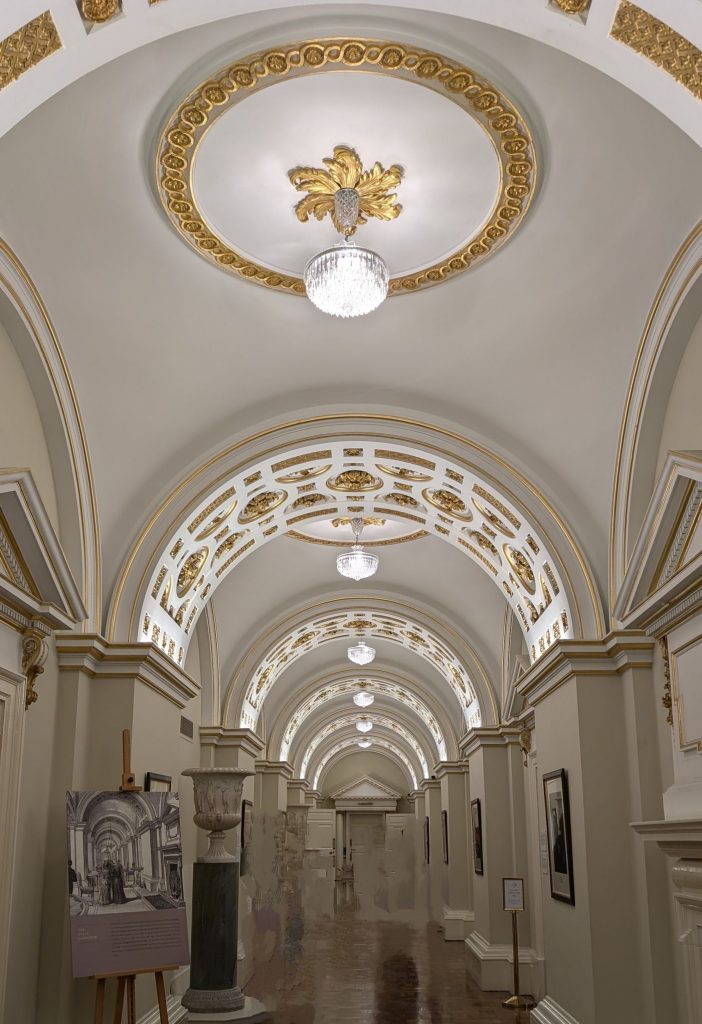
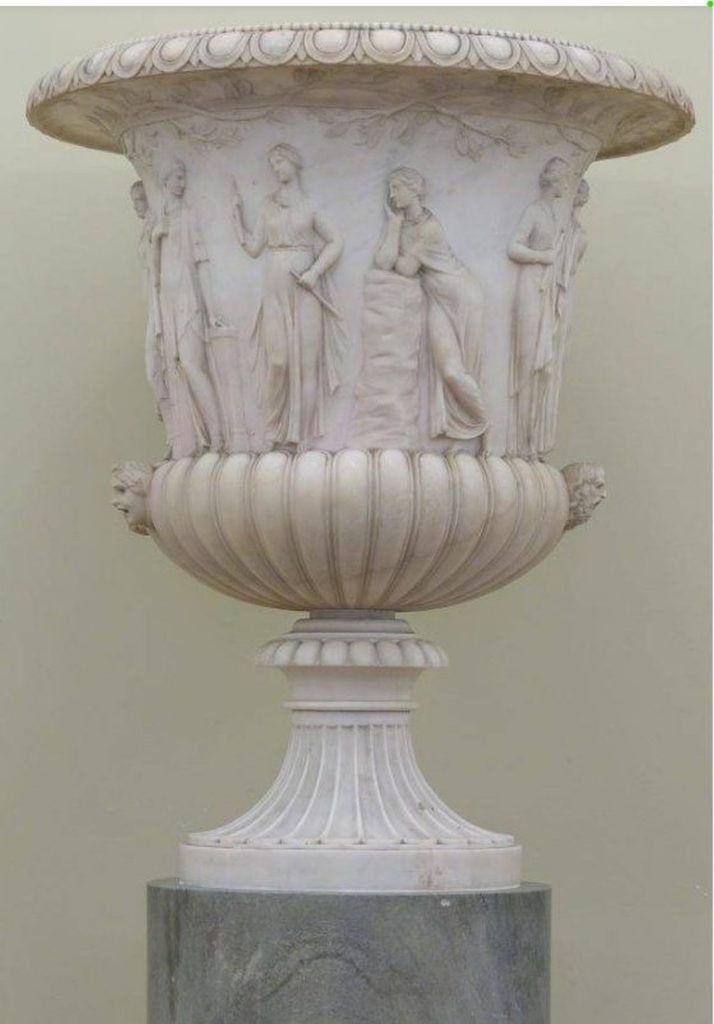
The Apollo Room
The Apollo Room derives its name from the figure of the mythological Greek god of the arts and music, Apollo. Having been rescued from a nearby Georgian townhouse in 1912, this room was installed in the State Apartments in the 1960s during an ambitious restoration project. Inscribed with the date 1746, the ceiling arrived at Dublin Castle in eleven separate pieces that were seamlessly reunited to form a superb example of eighteenth-century craftsmanship. (I could not find the seams where the ceiling was pieced together.)
The literature calls out the central figure on the ceiling: Apollo, god of the sun and of music. He is identified by a sunburst and a lyre.
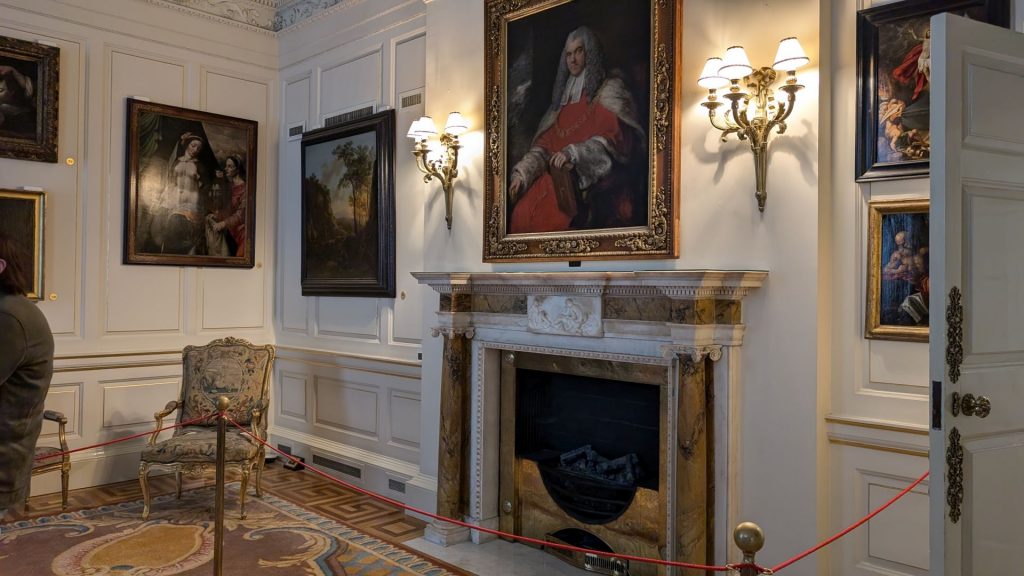
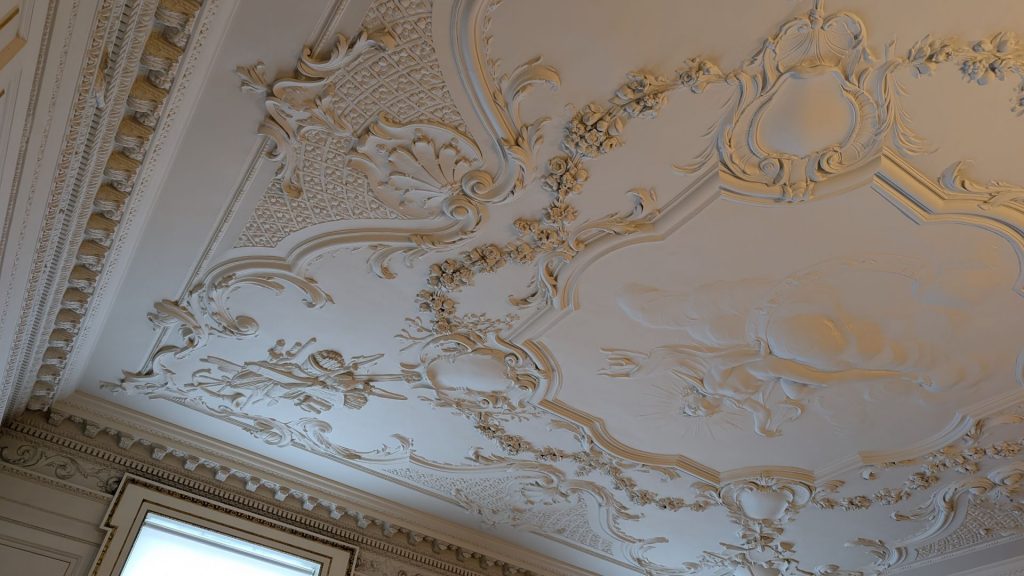
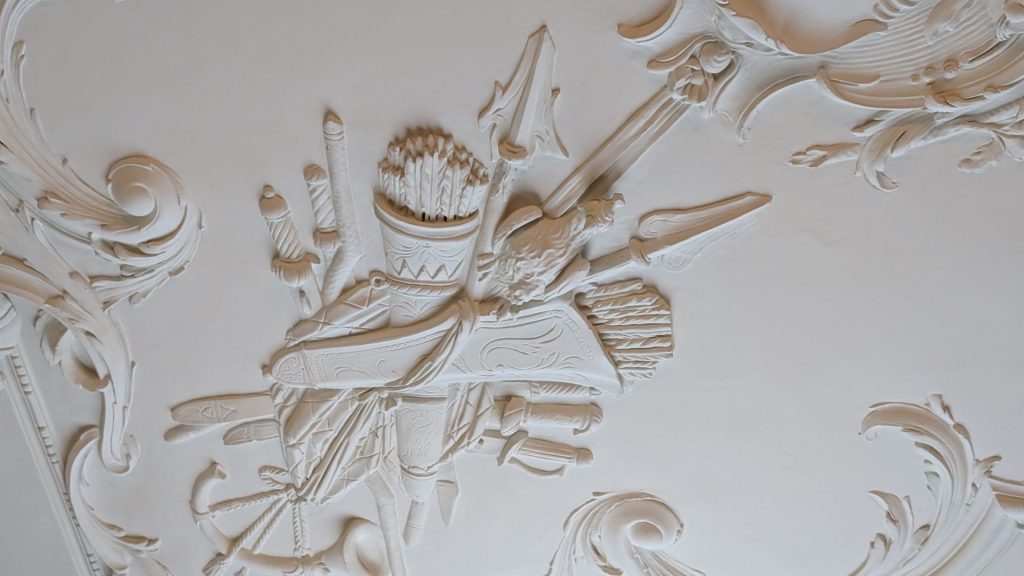
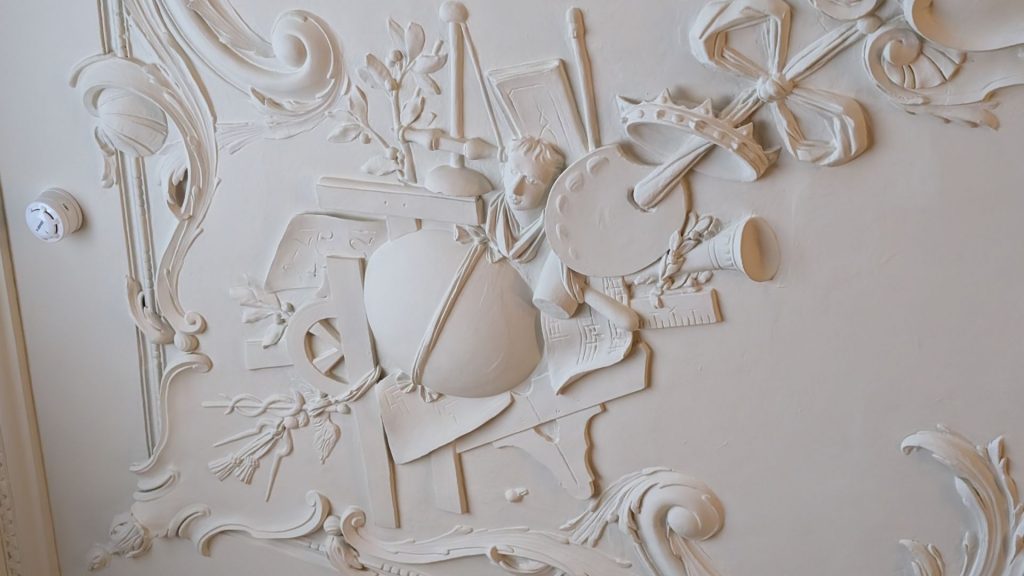
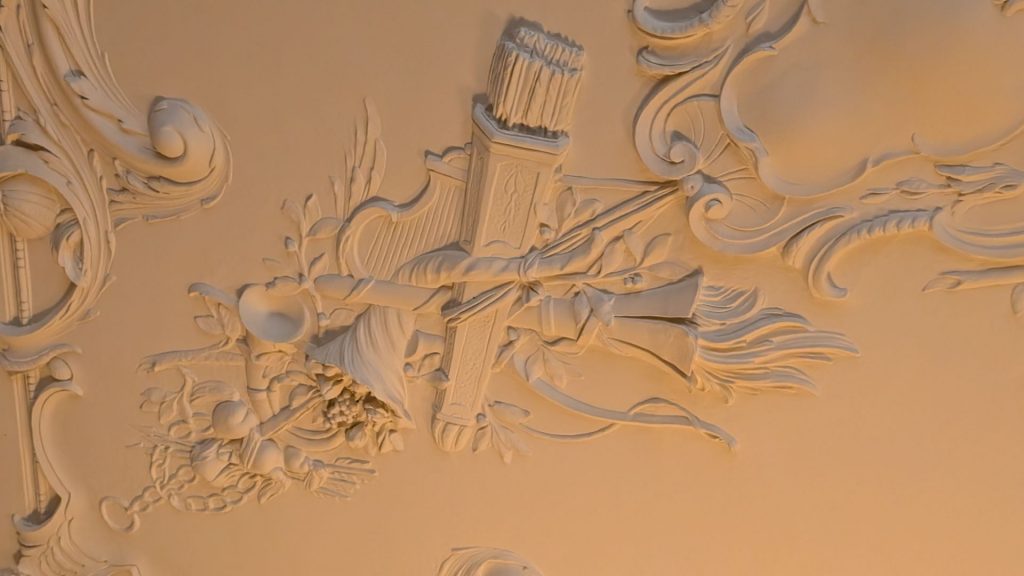
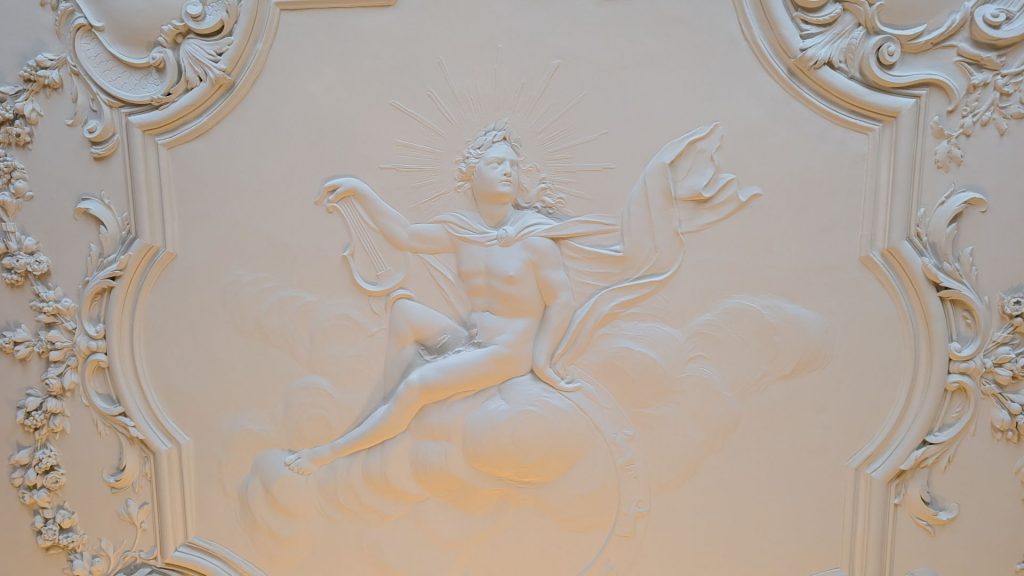
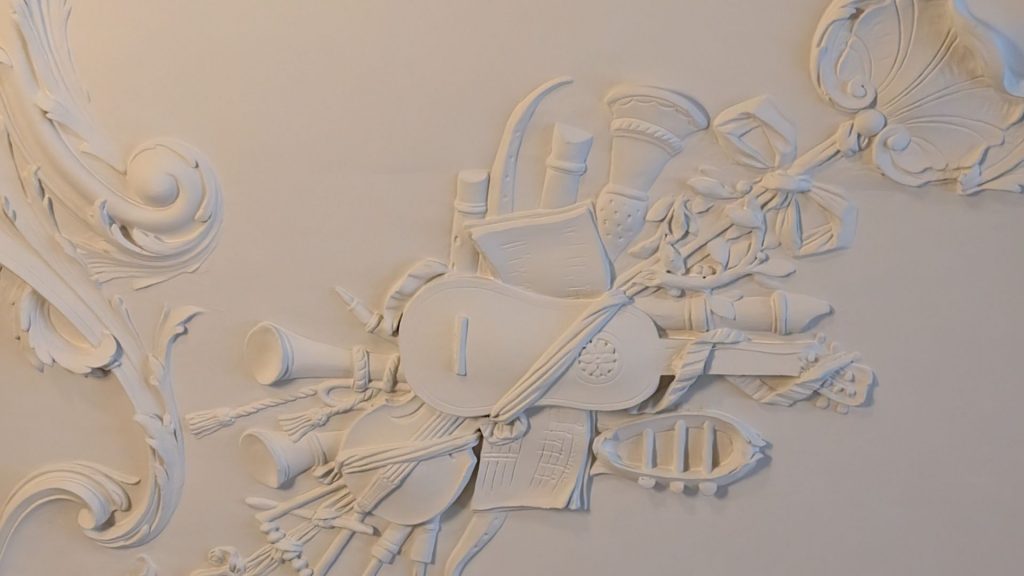
This artwork (below), hanging on the wall of the Apollo room, is titled, Judith with the Head of Holofernes. Artist: Vincent Sellaer (c. 1500-before 1589). Judith, the Jewish heroine, has just beheaded the military commander Holofernes and prepares to place his head in a sack held open by her maid. The painting represents the triumph of the Jews over their enemies, the Assyrians, as recounted in the Book of Judith. Judith, a widow, adorned herself in rich clothing and tricked the Assyrian commander Holofernes into believing that she had defected to his side. Charmed by her, he organized a banquet in her honor, following which Judith took advantage of his drunken state to behead him. The two themes commonly associated with this scene in the history of art are the triumph of virtue over vice and the misfortune of man at the hands of a scheming woman.
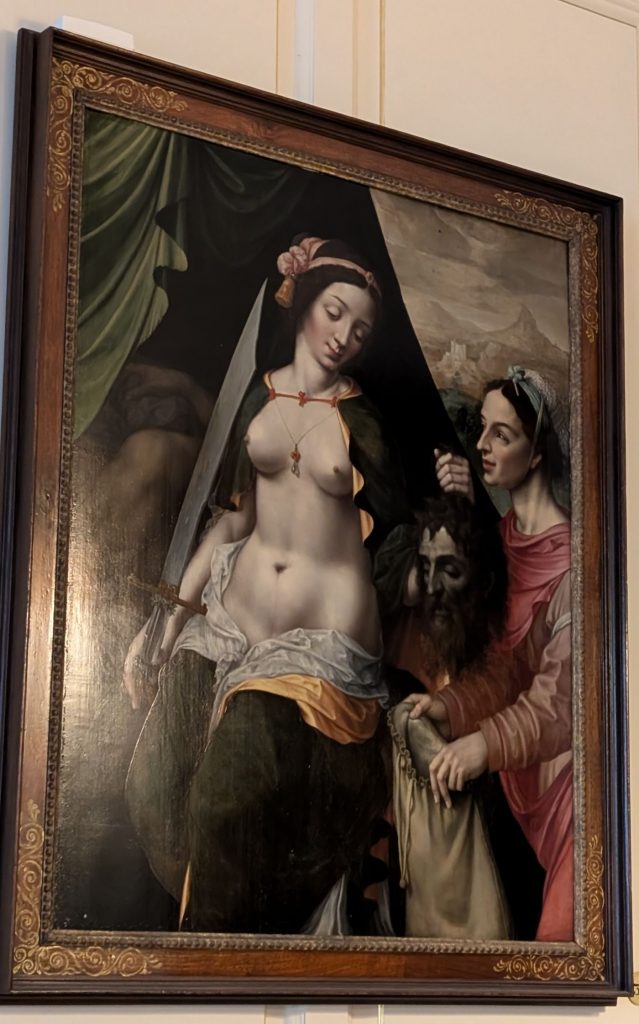
The State Drawing Room
The term “drawing room” comes from the tradition of withdrawing to a more comfortable room in a grand house. The State Drawing Room was created in 1838 and was used mainly by successive Vicereines (the wives of the Viceroys) as a formal sitting room and for holding audiences with Irish courtiers. During the royal visits of 1907 and 1911 Queen Alexandra and Queen Mary also received guests in this room. The room is still used by the President of Ireland for the reception of visiting dignitaries.
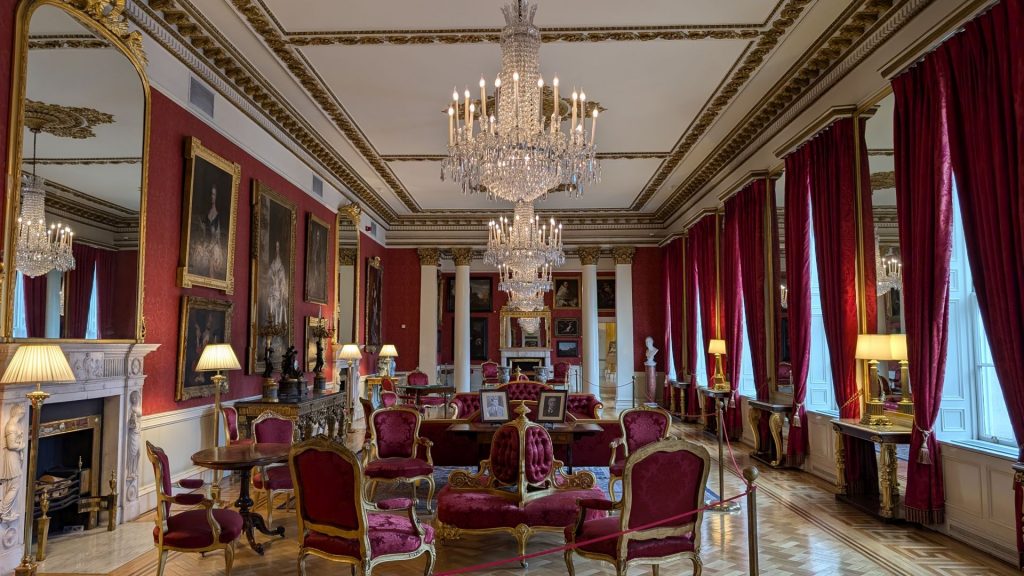
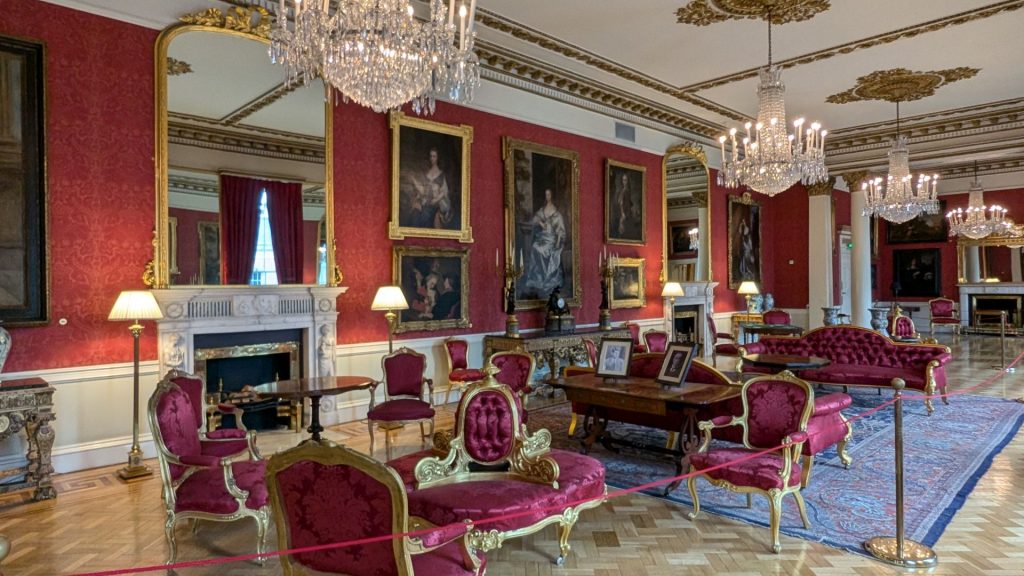
The Throne Room
The Throne Room was once the epicenter of royal ceremony in Ireland. It was created in 1788 as an audience chamber in which the Viceroy received guests on behalf of the British monarch. It was also where young debutantes were presented at court to mark their formal entry into aristocratic society. The throne was made for the visit to Ireland of King George IV, in 1821. It was later used by Queen Victoria and King Edward VII during their visits to the Castle. The last monarch to use it before Irish independence was King George V, in 1911. On display over the doors in this space are six important mythological paintings by the Italian artist Gaetano Gandolfi, painted in 1767.
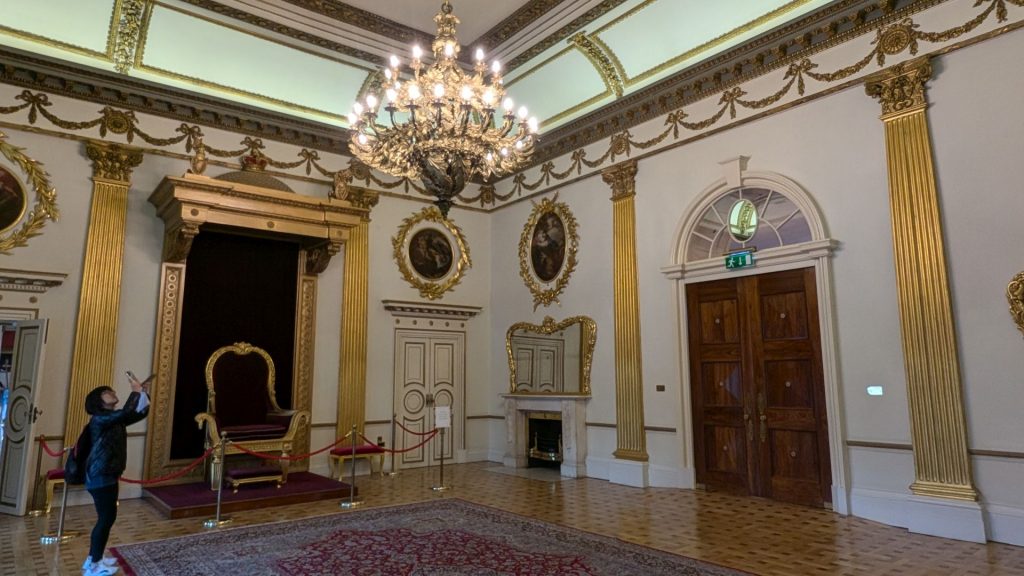
The Portrait Gallery (a.k.a. The State Dining Room)
This is the oldest room in the castle and largely retains its original decoration, having escaped major modification and fire over the years. It dates from Lord Chesterfield’s building of the State Apartments in the 1740s. The room’s main function was as a dining room where State dinners were held. In the early eighteenth century, expensive and exotic foods such as anchovies, mangoes, caviar and orange blossom water were served here, reflecting the wealth and status of the Viceroy and his court. The room continues to be used for State receptions by the Irish government today. The dining table is laid with Waterford crystal and the Irish State dinner service, which features the national emblem, the gold harp.
This room contains a collection of portraits of Irish Viceroys that have hung on its walls since 1849.
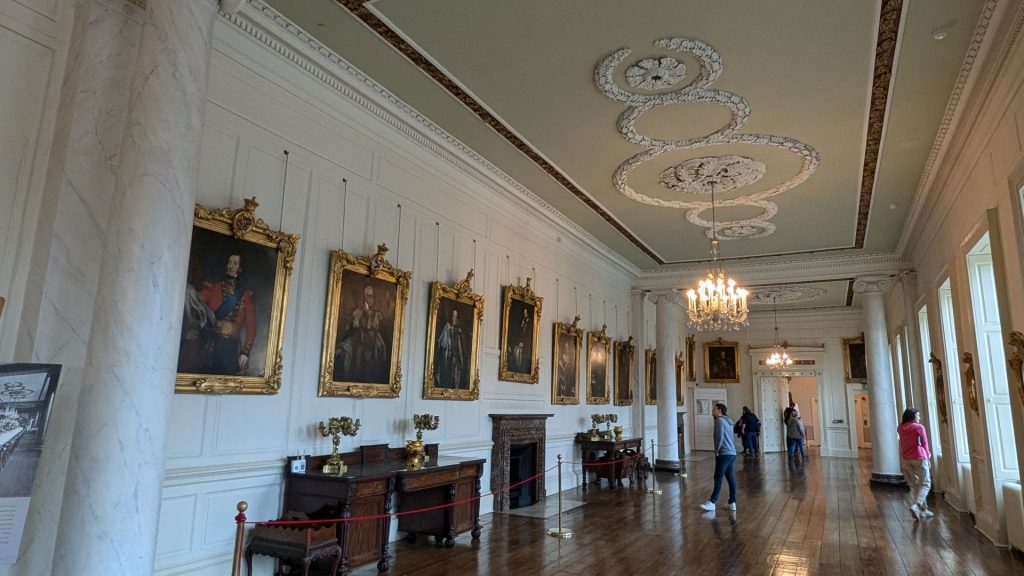
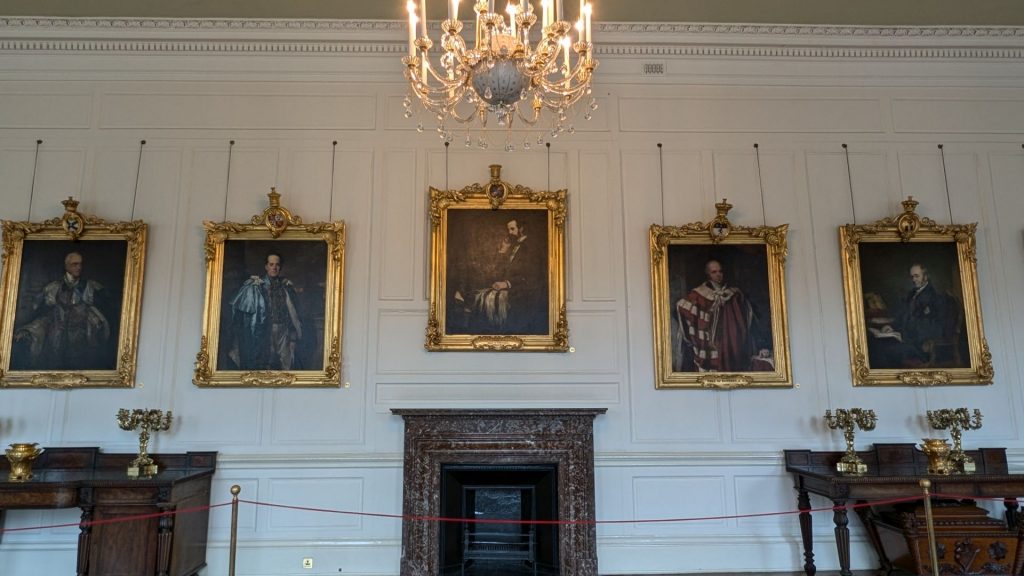
Hanging in The Portrait Gallery is this dramatic portrait of Earl Cadogan (below). As Viceroy of Ireland from 1895 to 1902, Cadogan demonstrated a relatively modern and progressive outlook, supporting the sale of lands to Irish tenants. Here his sky blue mantle of the Order of St Patrick is painted using thick impasto (heavily applied paint). The loose brushstrokes create an electric flash of color and a strong sense of movement.
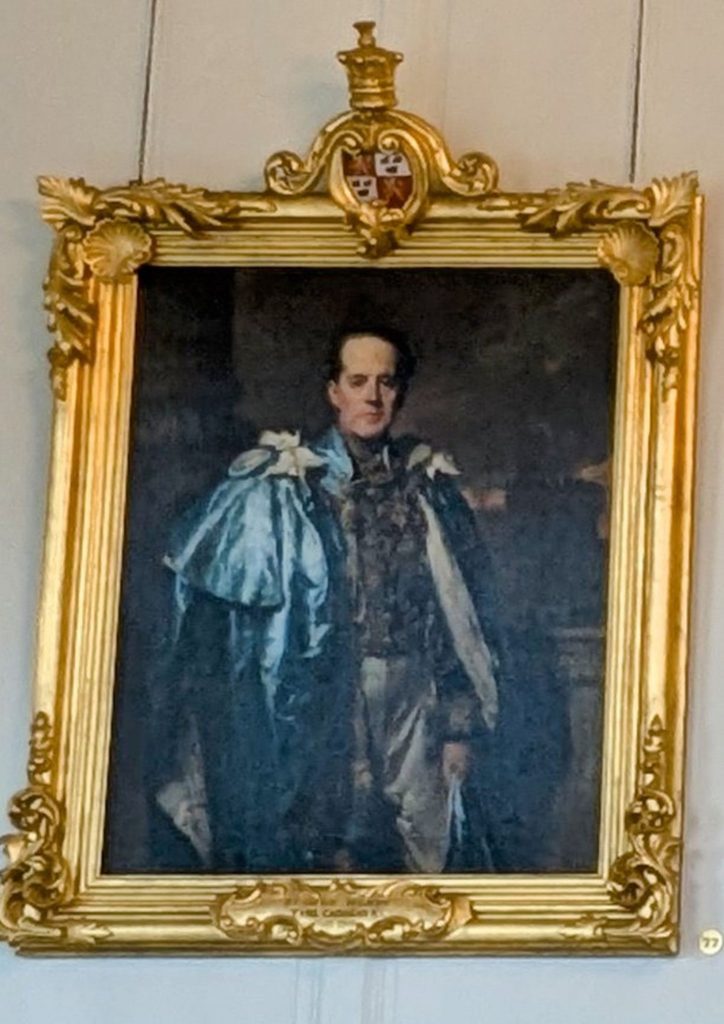
The Wedgwood Room
The Wedgwood Room takes its name from the blue and white decorative scheme that recalls the colors of Wedgwood pottery. It was completed in 1777 in the neoclassical style and later became the Castle’s billiard room. Lit only from above by a small glass-domed roof, it was a favorite place for the creation of temporary indoor gardens filled with exotic birds, trees and water fountains in the nineteenth century. These installations provided cooling refreshment for guests at the Castle’s crowded State balls and receptions.
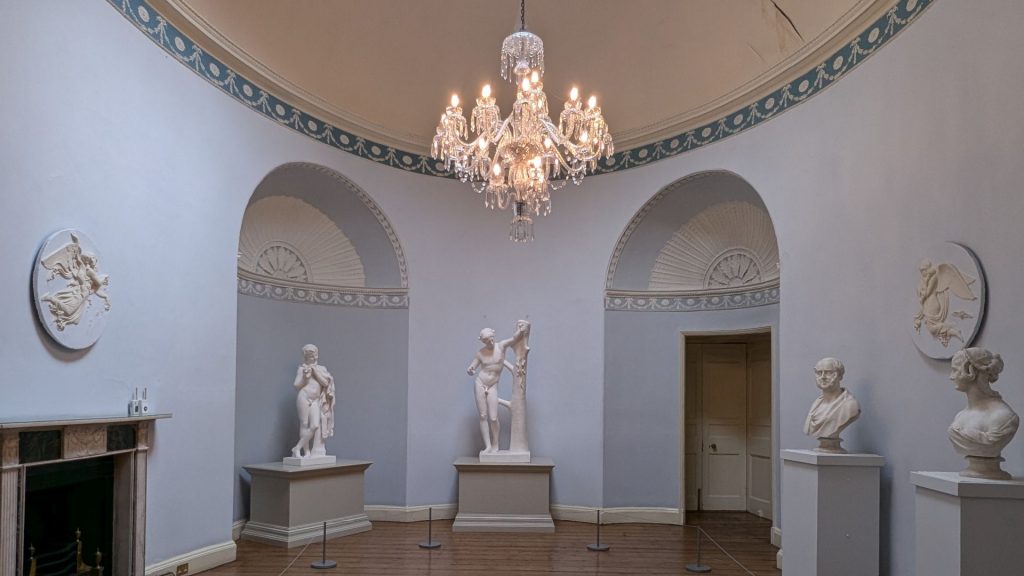
Saint Patrick’s Hall
Following the disestablishment of the Church of Ireland in 1871, the Order of St Patrick, Ireland’s order of chivalry, moved its ceremonial home from St Patrick’s Cathedral to St Patrick’s Hall. The banners and hatchment plates of the knights who were living at the time when most of Ireland gained a form of independence as the Irish Free State, in December 1922, remain in place.
This is the grandest room of the state apartments, and contains one of the most important decorative interiors in Ireland. Formerly the ballroom of the Lord Lieutenant’s administration, today the room is used for presidential inaugurations. If a President of Ireland dies in office, such as Erskine H. Childers in 1974, it is here that he or she lies in state. It is one of the oldest rooms in the castle, dating from the 1740s, though its decoration largely dates from c. 1790, including the most significant painted ceiling in Ireland, executed by Vincenzo Valdre (c. 1742–1814). Composed of three panels, the ceiling depicts the coronation of King George III, Saint Patrick introducing Christianity to Ireland, and King Henry II receiving the submission of the Irish chieftains. The state dinner hosted by the President of Ireland to welcome Queen Elizabeth II to Ireland was held here on the evening of May 18, 2011.
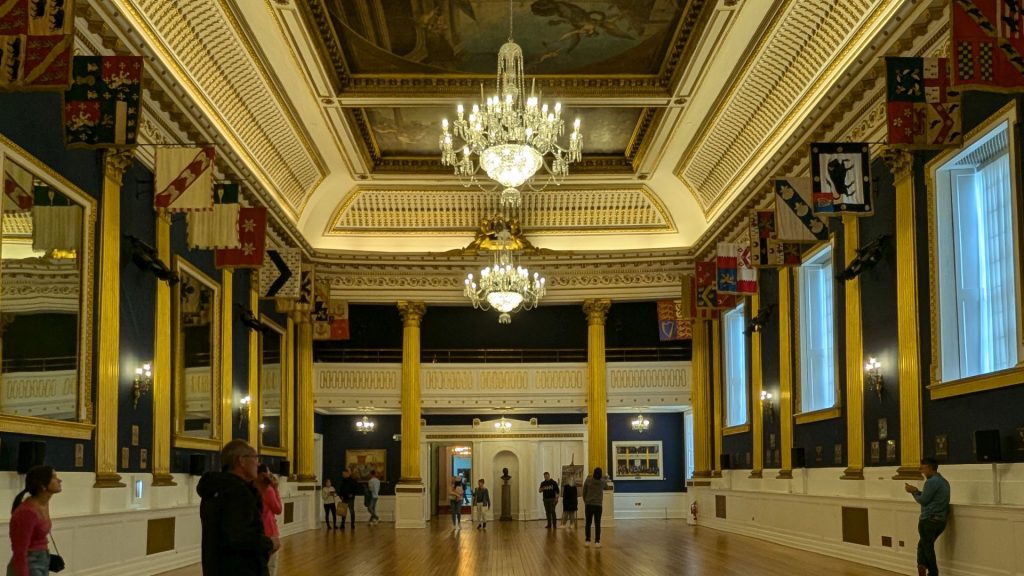
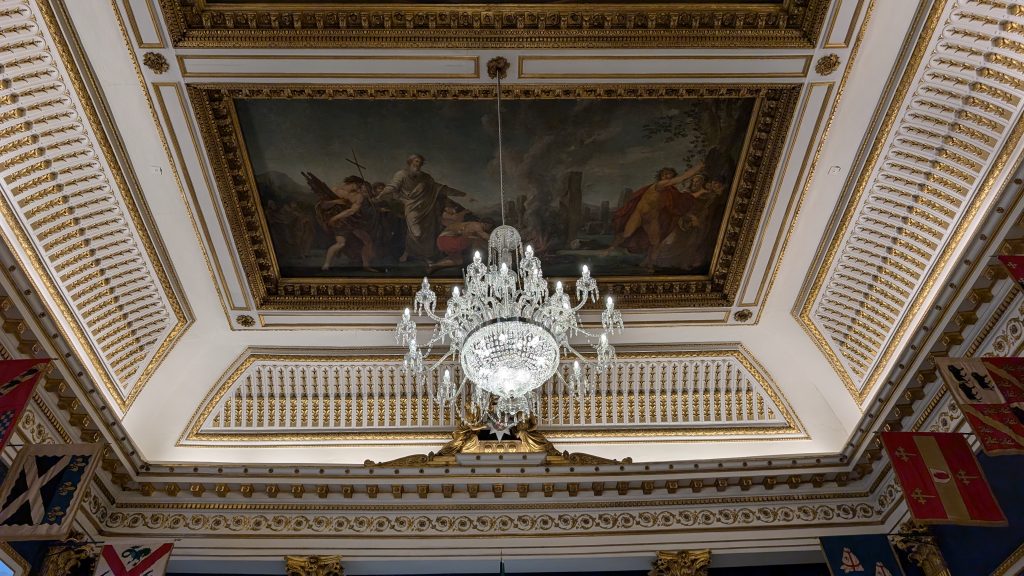
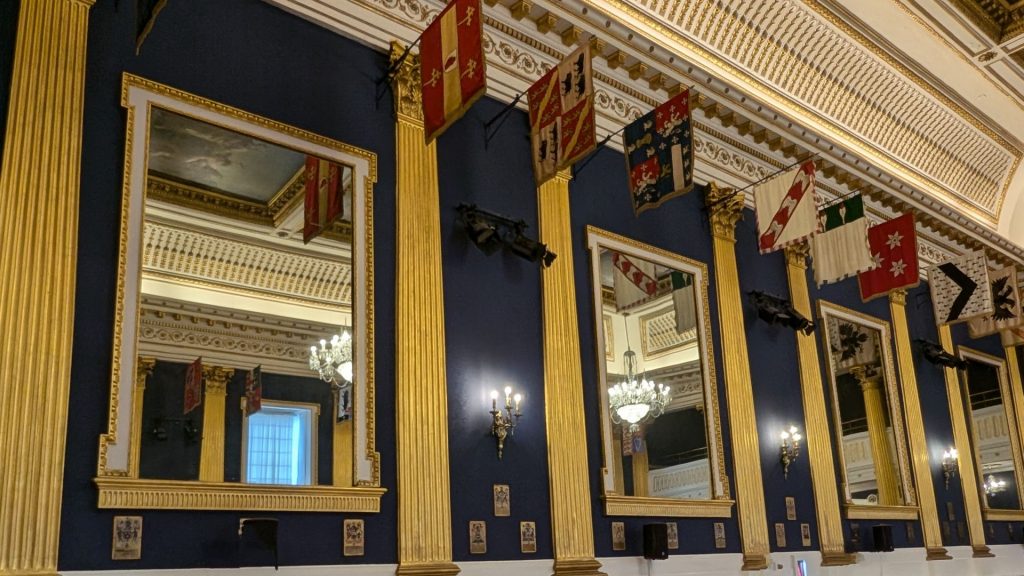
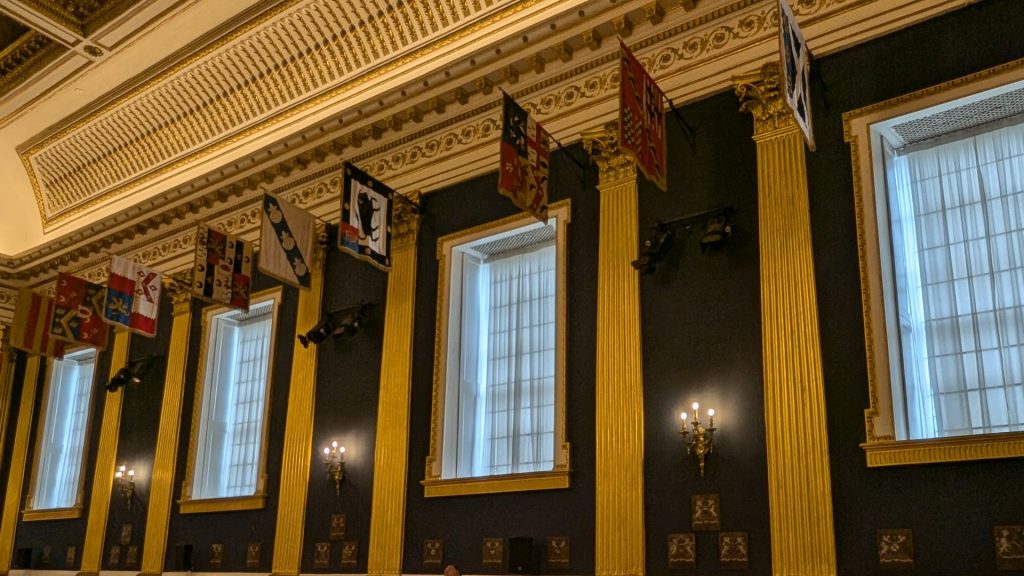
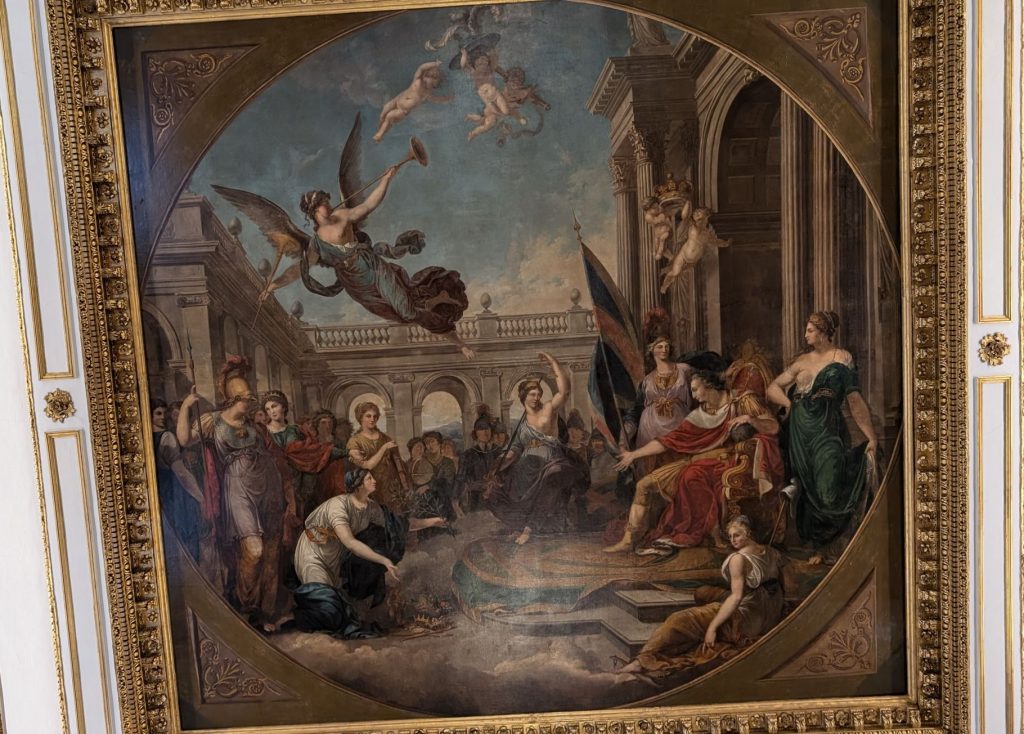
That’s it for the castle. A great place to visit, with a ton of history and artwork. There was also quite a bit of china on display. Here is one token picture:
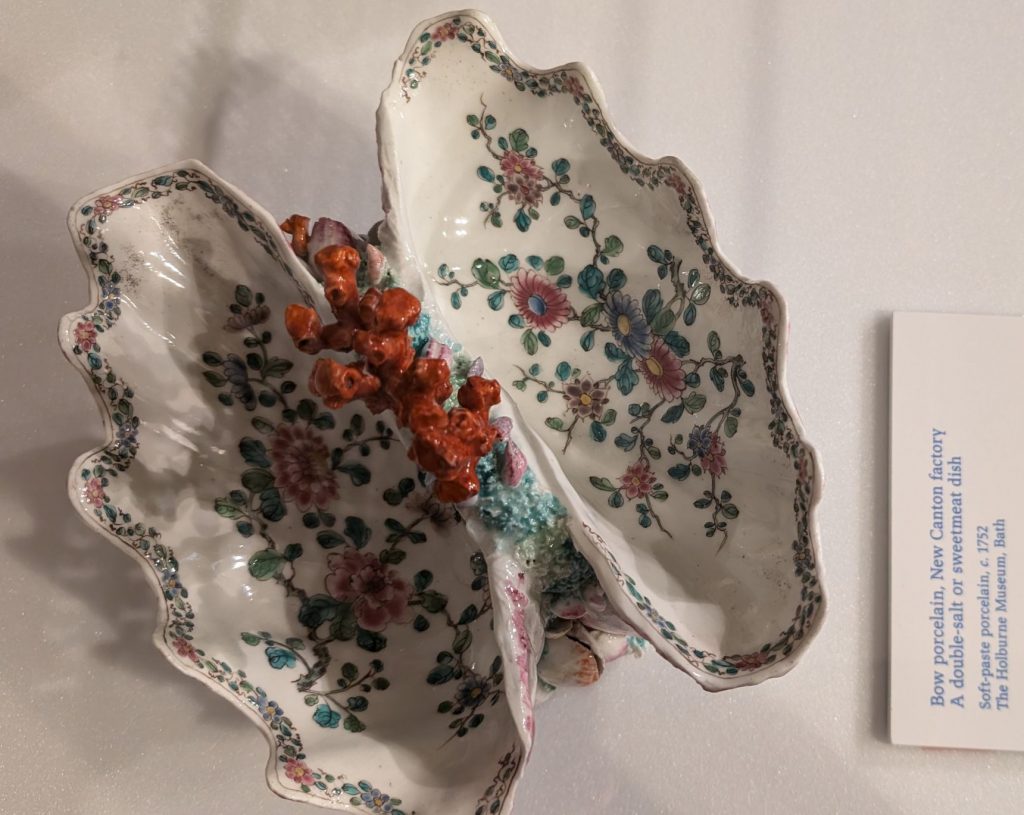
We had a nice walk to the pub, where we met my friend, Raine. It was a very small place but had wonderful cocktails! And I love the name.
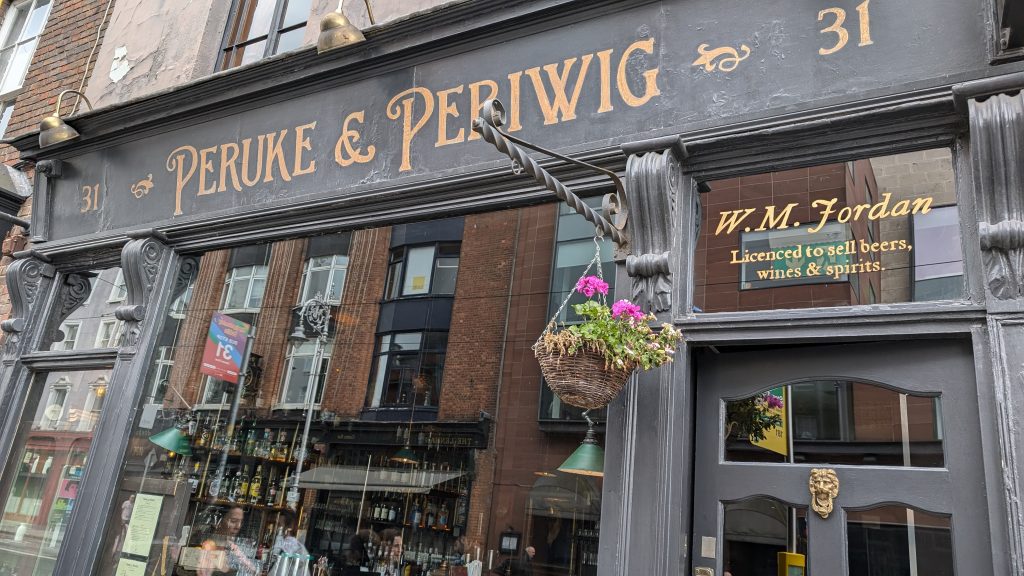
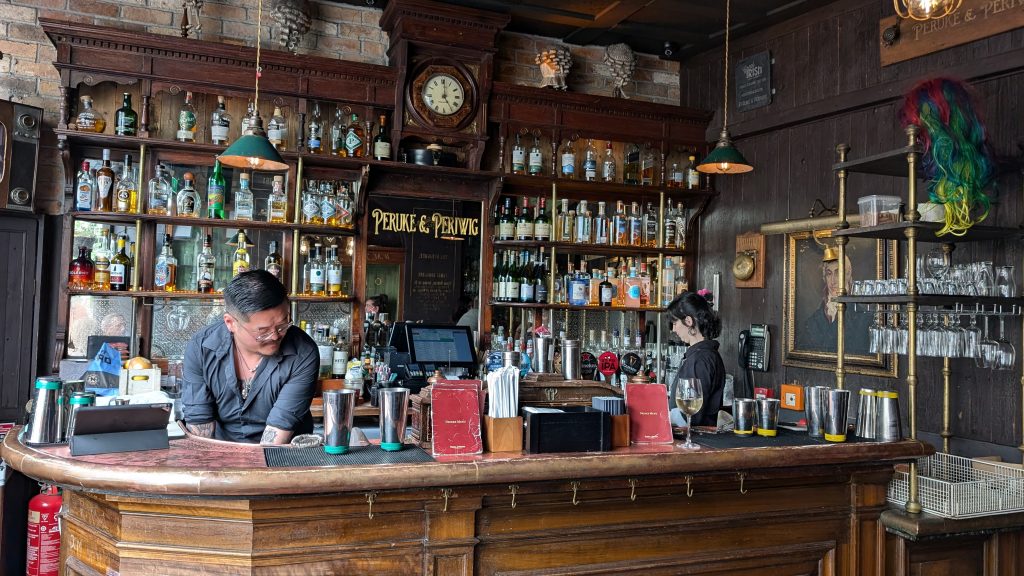
We stopped for dinner after meeting Raine. Here are some more of the sites we enjoyed along the way.
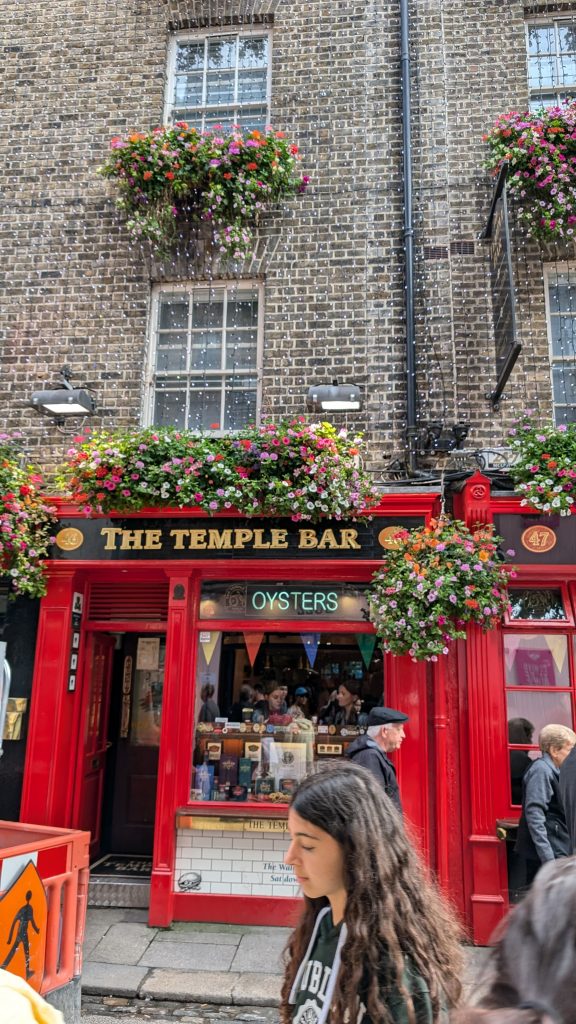
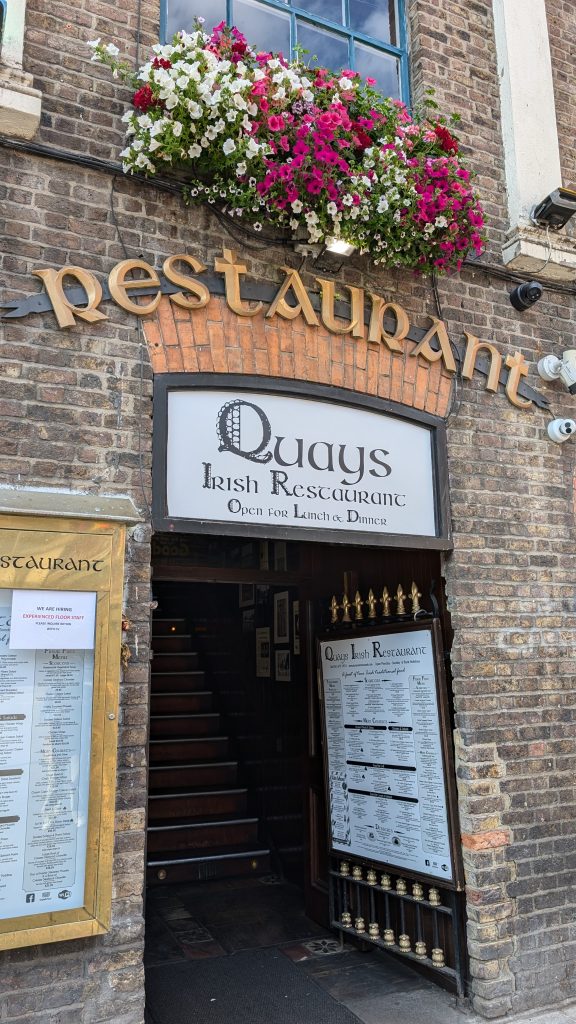
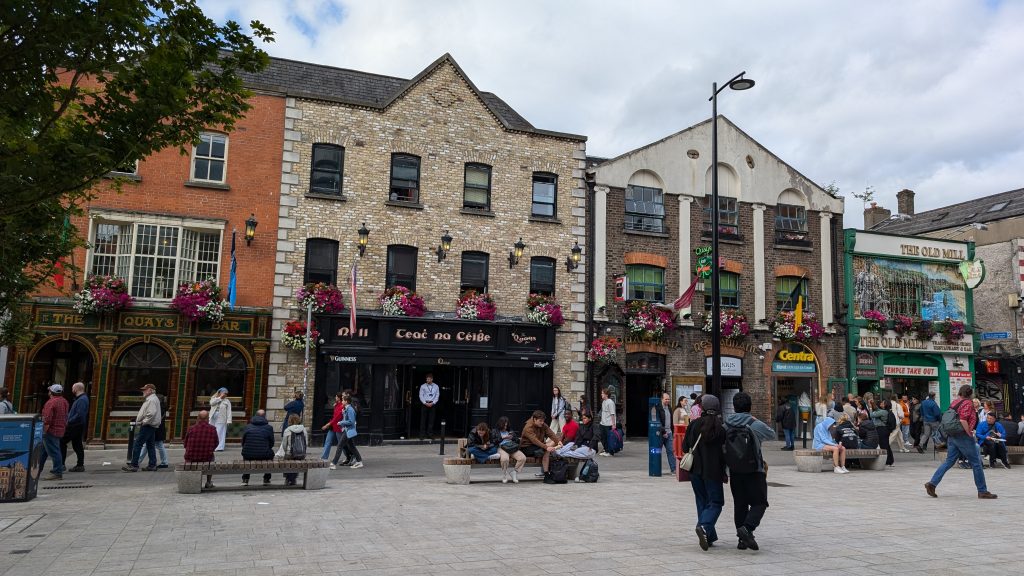
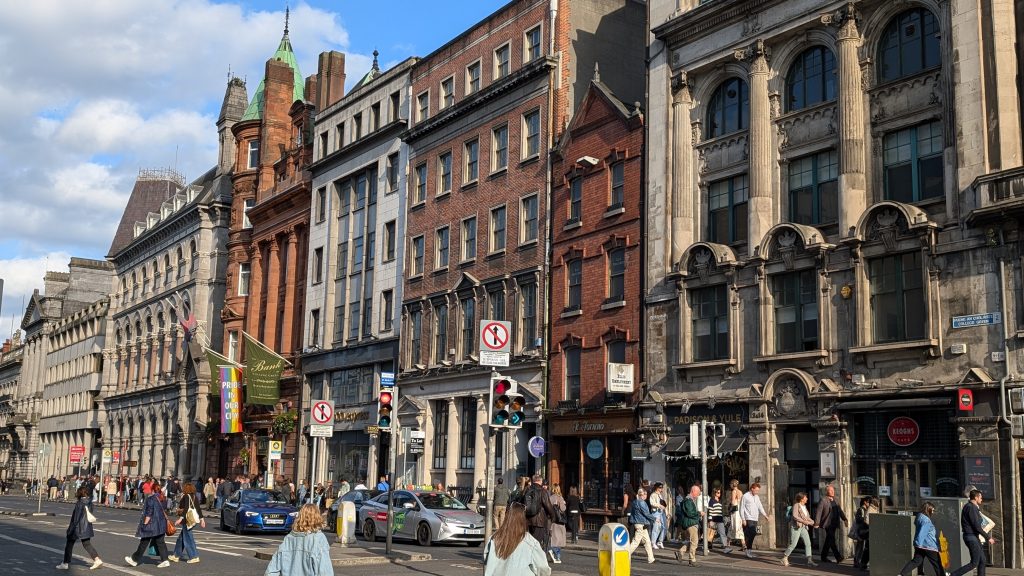
A bus and train ride later, we were back at our hotel in Balbriggan with the room with a big screen TV. As per usual, they were showing a football (a.k.a. soccer) game!
